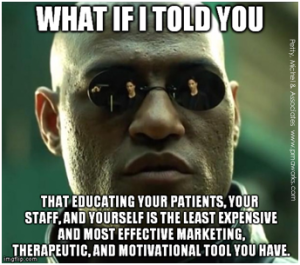The purpose of your newsletter is to keep the conversation going. It is designed to sustain the relationship that you have started. It can even help create new relationships. It serves to remind the patient that you are there for them and can continue to help them.
Marketing IS communication. Nothing beats live two-way communication – in person or via the phone. But next to live communication, the personal letter is best. The letter is a tried and true form of communication.
A newsletter is NOT a brochure, or a pamphlet, or regurgitated “content.” It is a personal communication from you to someone else. Too many newsletters are mass produced and have generic types of “content.” The one thing that is becoming more valuable in today’s world is authenticity. This is important because it creates trust – which is also scarce. So, keep your newsletter personal, even “folksy” and your patients will feel that the real you is talking to the real them and will have a greater impact.
Components of a patient newsletter should include some the following:
1. Letter from the Clinic Director
A short letter to the patients from the Clinic Director anchors the newsletter. If you include nothing else, this is the most important part of your newsletter.
It can be short or long. Shorter is better, with only 4 or 5 paragraphs. A longer letter also works ONLY if it is compelling. A worthy story or rant against some injustice…these can work. If it expresses your VOICE, it will work.
Your letter should usually include some reference to you personally. For example: “Yesterday, when I was taking my kids to school, my youngest mentioned she was told that she needed to receive 43 vaccinations next week….”
You can include some health news, with statistics and cite a reference, or refer to an article in another part of the newsletter. You can include office news. Refer to a photo attached of the new carpet, painted wall, or gift from a patient. New research, celebrities utilizing similar services, recent chiropractic success cases in the office, clinic expansion or renovation, new computer system, and personal adventures … all of these are good.
This can also be done via a short video as well.
Whatever you say, it should be delivered as if you are talking to just one person, perhaps the last patient you just saw. End the letter by saying something like… “I look forward to seeing you soon.”
2. Health Tips
Information for a “Health Tips” column, such as “Health Sleep Habits for Kids” The topic should be consistent with the time of year (September – back to school month) or Community Education Program theme (Children’s Health). Dr. Mercola has built his empire with great health tips from his newsletter. If you are not a subscriber, I encourage you to look into it. (www.mercola.com)
3. Special Promotions
Information on any upcoming promotions, spinal care classes, community education lectures, or anything else of a special nature.
4. Staff News
Include any news about staff, such as a new baby, new staff, new staff promotion, continuing education or seminar attendance. Pictures please.
5. Doctor/Clinical News
Include news about doctors, such as new seminars attended, advanced training, specialties, new associates, new diagnostic or treatment equipment, etc.
6. Patient News
Any news that is appropriate about patients, such as patient of the month, patient success stories (include photograph of patient), patient news: “Joe Smith wins the lottery and enrolls at Palmer!” Ensure you have a signed release from any patients that you want to include information about. Some clinics like to include a copy of their “thank you for referring board.”
7. Community Education Calendar
List the dates, times, places, and other pertinent information about community events that you will be sponsoring during the next month or quarter.
8. Just for Fun
Begin a recipe column. Assign this to one of the staff as appropriate. For example, if your office manager’s name is Jean, have a column called “Jean’s Recipes”. Each month, Jean can feature a different recipe, including, for example, the doctor’s favorite special chili recipe. Recipes should be simple (or at least not take up too much space). “Jean” should make some comments about the recipe.
9. Cartoons and Jokes!
Newsletter CONTENT Checklist
Submitted in digital format (Via computer). Bonus if you include photos or even a video.
- Letter from the Clinic Director
- Health Tips
- Special Promotions Upcoming
- Staff News
- Doctor/Clinical News
- Patient News
- Community Education Calendar
- Just for Fun
- Cartoons and Jokes



